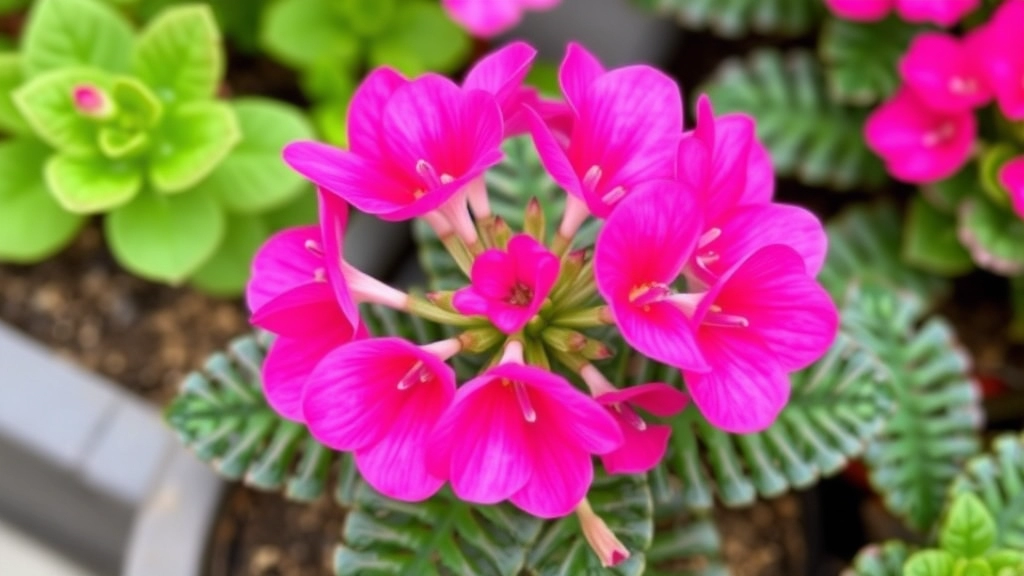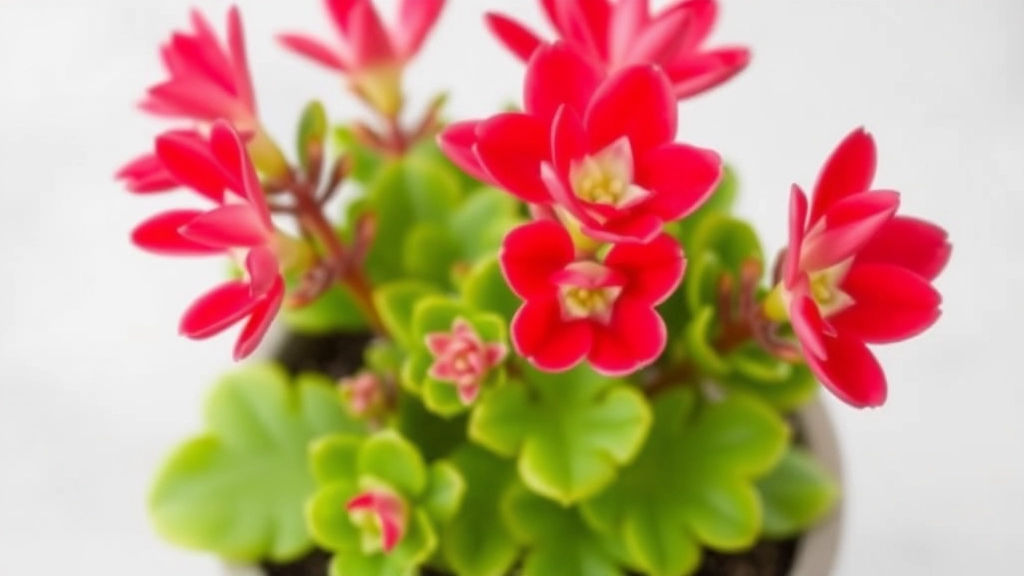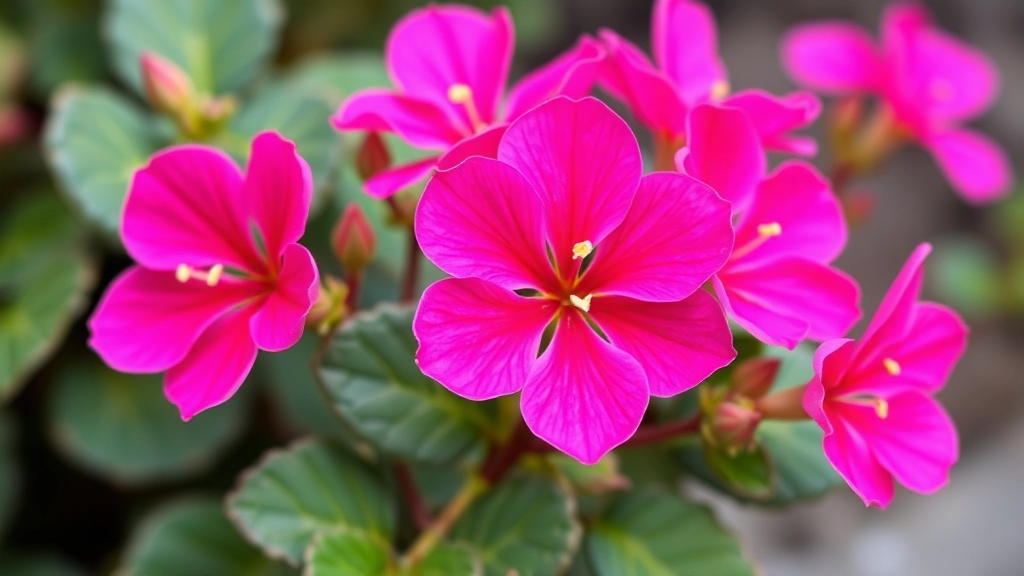Pink Kalanchoe Flowers
Pink Kalanchoe flowers are a stunning addition to any garden, known for their vibrant hues and long-lasting blooms. These hardy succulents are perfect for both indoor and outdoor settings, making them a versatile choice for plant enthusiasts. With their thick, fleshy leaves and bright pink flowers, Kalanchoe plants are not only visually appealing but also relatively low-maintenance.
Care Tips for Pink Kalanchoe
To ensure your Pink Kalanchoe thrives, it’s essential to follow some basic care tips. These plants prefer well-draining soil and moderate sunlight, making them ideal for windowsills or shaded garden spots. Regular watering is crucial, but be careful not to overwater, as Kalanchoe is prone to root rot.
Understanding Kalanchoe Needs
By understanding the characteristics and care needs of Pink Kalanchoe flowers, you can enjoy their beauty year-round.
**Characteristics of Pink Kalanchoe Flowers**
When considering vibrant additions to your indoor or outdoor space, the Pink Kalanchoe stands out as a popular choice.
These flowers are not only visually appealing but also possess unique characteristics that make them special:
– **Colour and Appearance**: The Pink Kalanchoe features clusters of small, delicate flowers that bloom in various shades of pink, ranging from soft pastels to vibrant hues. These flowers often have a waxy texture, giving them a lush appearance.
– **Foliage**: The plant itself boasts thick, succulent leaves that are typically a rich green. This contrast enhances the beauty of the pink blooms, making them even more striking.
– **Size**: Pink Kalanchoe plants generally grow to a height of 30 to 45 cm (12 to 18 inches), making them suitable for both potting and garden displays.
– **Blooming Period**: These flowers typically bloom in late winter to early spring, adding a splash of colour when many other plants are dormant.
– **Longevity**: Once established, Kalanchoe flowers can last for several weeks, providing a long-lasting display of beauty.
The unique blend of colour, texture, and longevity makes Pink Kalanchoe a favourite among gardeners and plant lovers alike. For more detailed care tips, you can explore our [complete guide to growing and caring for Kalanchoe Pink Butterflies](https://planthq.org/complete-guide-to-growing-and-caring-for-kalanchoe-pink-butterflies/). Additionally, if you’re interested in different varieties, check out our [top Kalanchoe varieties with pink edges](https://planthq.org/top-kalanchoe-varieties-with-pink-edges/).
Care Tips for Growing Pink Kalanchoe

So, you’ve got your eye on those stunning pink Kalanchoe flowers, but how do you keep them thriving?
First off, let’s chat about light.
Light Requirements
- Bright, Indirect Light: Kalanchoe loves the sun but too much direct sunlight can scorch those lovely leaves.
- Rotate Regularly: Give all sides a chance to soak up the rays by rotating your pot every now and then.
Watering Wisely
- Drench and Dry: Water thoroughly, then let the soil dry out before the next drink. Overwatering is a common pitfall.
- Check the Soil: Stick your finger in the soil; if it’s dry an inch down, it’s time to water.
Temperature and Humidity
- Ideal Range: Keep them in a cozy spot between 15°C and 24°C. They’re not fans of frost!
- Low Humidity: Kalanchoe prefers a drier environment, so don’t fuss too much about humidity levels.
Fertilizing
- Feed Sparingly: Use a balanced, water-soluble fertiliser every few weeks during the growing season. Less is more!
Pruning and Deadheading
- Keep it Neat: Trim off any dead or wilted flowers to encourage new blooms.
- Shape It Up: If it gets leggy, don’t hesitate to prune back the stems to promote bushier growth.
Potting and Soil
- Well-Draining Soil: Use a cactus mix or add perlite to regular potting soil for better drainage.
- Choose the Right Pot: Ensure your pot has drainage holes to prevent soggy roots.
Common Pests and Diseases of Kalanchoe
As we delve deeper into the care of Pink Kalanchoe, understanding the common pests and diseases that can affect these beautiful plants is crucial. Knowing how to identify these issues early can save your plant from serious damage.
Common Pests
- Mealybugs
- Small, white, cotton-like clusters found on leaves and stems.
- They suck the sap, leading to yellowing leaves and stunted growth.
- Aphids
- Tiny, green or black insects that congregate on new growth.
- They can cause leaf curling and promote sooty mould.
- Spider Mites
- Very small and often go unnoticed until damage appears.
- Look for tiny webs and speckled leaves.
- Scale Insects
- Hard, shell-like exterior that can be mistaken for plant bark.
- They also feed on sap, weakening the plant.
Common Diseases
- Leaf Spot
- Caused by fungal infections, leading to dark spots on leaves.
- Ensure good air circulation and avoid overhead watering.
- Root Rot
- Often a result of overwatering or poorly draining soil.
- Symptoms include wilting and a foul smell from the roots.
- Powdery Mildew
- A white, powdery substance on leaves indicating high humidity.
- Improve ventilation and reduce humidity levels to combat this.
Prevention and Treatment
- Regular Inspection: Check your plants regularly for early signs of pests and diseases. For more detailed tips, refer to our guide on black spots on Kalanchoe leaves.
- Proper Watering: Ensure the soil dries out between waterings to prevent root rot. You can learn more about optimal watering practices in our Kalanchoe Tomentosa watering guide.
- Neem Oil: A natural pesticide effective against many pests.
- Remove Affected Leaves: Trim any infested or diseased parts promptly.
Propagation Methods for Kalanchoe Plants

Are you wondering how to multiply your beautiful Pink Kalanchoe plants? Propagation is a rewarding process that can lead to more vibrant blooms in your garden.
Propagation Techniques
There are several effective methods to propagate Kalanchoe plants. Here’s a quick rundown:
- Leaf Cuttings:
- Select a healthy leaf and cut it from the plant.
- Allow it to dry for a few days until the cut surface calluses.
- Place it in well-draining soil and water sparingly until roots develop.
- Stem Cuttings:
- Take a 4-6 inch stem cutting from a healthy plant.
- Remove the lower leaves to expose the nodes.
- Let the cutting dry for a day before planting it in soil.
- Water lightly and maintain humidity until roots form.
- Offsets:
- Kalanchoe often produces offsets or “pups” around the base.
- Gently separate these pups from the mother plant.
- Replant them in their own pots with suitable soil.
Tips for Successful Propagation
- Timing:
- The best time to propagate is during the growing season, typically in spring or early summer.
- Soil:
- Use a well-draining potting mix to prevent rot.
- Light:
- Place the cuttings in bright, indirect light for optimal growth.
- Watering:
- Water only when the soil has dried out to avoid overwatering.
By following these propagation methods, you can easily expand your Kalanchoe collection.
Creative Uses for Pink Kalanchoe in Landscaping
As we explore the vibrant world of Pink Kalanchoe, it’s essential to consider how these stunning flowers can enhance your outdoor spaces.
1. Container Gardens
Pink Kalanchoe is perfect for container gardening. Their compact size and striking blooms make them ideal for:
- Patios: Brighten up your seating area.
- Balconies: Add colour without taking up too much space.
- Entryways: Create inviting entrances with pots filled with Kalanchoe.
2. Flower Beds and Borders
Incorporating Pink Kalanchoe into flower beds can add a pop of colour. Consider:
- Mixed Borders: Combine with other flowering plants for a vibrant display.
- Edging: Use Kalanchoe to create defined edges around pathways.
3. Rock Gardens
These resilient plants thrive in well-drained soil, making them perfect for rock gardens. Their unique texture and colour can:
- Contrast with stones and gravel.
- Provide a low-maintenance option for busy gardeners.
4. Indoor Landscaping
Not just for outdoor use, Pink Kalanchoe can brighten up indoor spaces too. Use them in:
- Brightly lit rooms: Their vibrant flowers can uplift any space.
- Office settings: A splash of colour can enhance productivity.
5. Seasonal Displays
Kalanchoe can be used in seasonal displays, complementing other seasonal plants. Consider:
Seasonal Blooming and Maintenance of Kalanchoe
Ever wondered how to keep your Pink Kalanchoe blooming beautifully throughout the seasons?
Let’s dive into the seasonal care that will help your Kalanchoe thrive.
Seasonal Blooming
Blooming Period
Kalanchoe typically blooms in late winter to early spring. The vibrant pink flowers can last for weeks, making it a delightful addition to any space.
Light Requirements
During the blooming season, ensure your Kalanchoe gets plenty of bright, indirect sunlight. Too much direct sun can scorch those lovely petals.
Watering Tips
- Water when the top inch of soil feels dry.
- Avoid waterlogging; Kalanchoe prefers to dry out between waterings.
- Use room temperature water for the best results.
Maintenance Throughout the Year
Post-Bloom Care
Once your Kalanchoe has finished blooming, it’s not the end! Here’s how to keep it healthy:
- Trim off spent flowers to encourage new growth.
- Reduce watering slightly; the plant doesn’t need as much moisture when it’s not in bloom.
Fertilisation
- Feed with a balanced, water-soluble fertiliser every month during the growing season (spring and summer).
- Cut back on fertiliser in the fall and winter months.
Humidity and Temperature
- Kalanchoe loves warmth. Keep it in a spot where temperatures range between 15°C to 25°C.
- Avoid cold drafts and sudden temperature changes.
Repotting
- If your Kalanchoe outgrows its pot, consider repotting in the spring.
- Choose a pot that’s slightly larger and has good drainage.
By following these simple seasonal care tips, you’ll keep your Pink Kalanchoe blooming beautifully year after year. For more detailed guidance, don’t miss our complete care guide for Kalanchoe Blossfeldiana. Additionally, if you’re curious about the different varieties, check out the top Kalanchoe succulent varieties and care tips.
FAQs About Pink Kalanchoe Flower Care and Propagation
What kind of light do Pink Kalanchoe flowers need?
Pink Kalanchoe flowers thrive in bright, indirect light. Too much direct sunlight can scorch their leaves, so it’s important to provide them with filtered light. Additionally, rotating the pot regularly helps ensure even light exposure.
How should I water my Pink Kalanchoe?
Follow a drench and dry method: water thoroughly, then allow the soil to dry out before watering again. Overwatering can lead to root rot, so it’s crucial to check the soil moisture by sticking your finger an inch deep into the soil. If it feels dry, it’s time to water.
What temperature and humidity levels are ideal for Pink Kalanchoe?
Pink Kalanchoe plants prefer a temperature range between 15°C and 24°C. They are not frost-tolerant and prefer low humidity, making them suitable for drier environments.
How often should I fertilize my Pink Kalanchoe?
Use a balanced, water-soluble fertilizer sparingly, typically every few weeks during the growing season. Over-fertilizing can harm the plant, so less is more in this case.
How do I prune and deadhead my Pink Kalanchoe?
Prune off any dead or wilted flowers to encourage new blooms and keep the plant looking neat. If the plant becomes leggy, prune back the stems to promote bushier growth.
What type of soil and pot is best for Pink Kalanchoe?
Use a well-draining soil mix, such as a cactus mix or regular potting soil with added perlite. Ensure your pot has drainage holes to prevent root rot.
What are the best methods for propagating Pink Kalanchoe?
There are several effective propagation methods:
- Leaf Cuttings: Cut a healthy leaf, let it dry until the cut surface calluses, then place it in well-draining soil.
- Stem Cuttings: Take a 4-6 inch cutting, remove the lower leaves, let it dry for a day, then plant in soil.
- Offsets: Separate the pups from the mother plant and replant them in their own pots.
When is the best time to propagate Pink Kalanchoe?
The optimal time for propagation is during the growing season, typically in spring or early summer. This ensures the new plants have enough time to establish before the dormant season.
What are some tips for successful propagation?
Use a well-draining potting mix, place cuttings in bright, indirect light, and water only when the soil has dried out to avoid overwatering. These steps will help ensure successful propagation.
By following these care and propagation tips, you can enjoy a thriving collection of beautiful Pink Kalanchoe flowers.
References
-
Kalanchoe Plant Care: How To Grow Kalanchoe
-
How to Grow Kalanchoe Indoors
-
Kalanchoe Care: Tips on Growing Kalanchoe Plants
